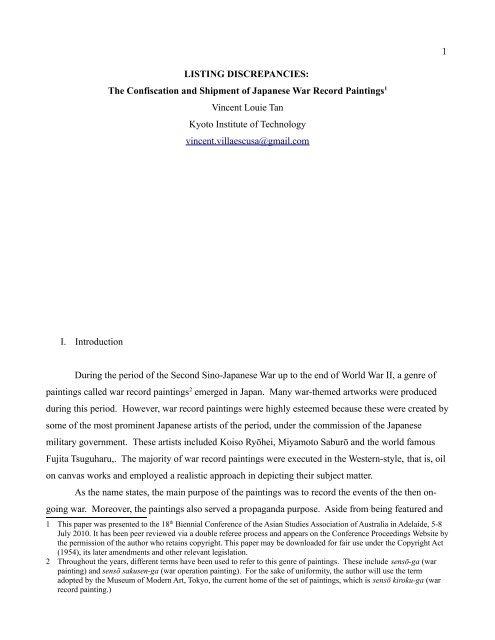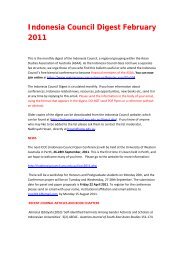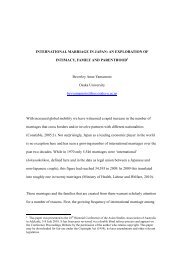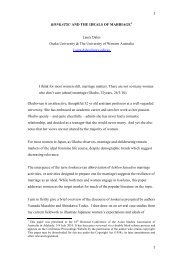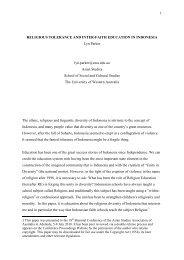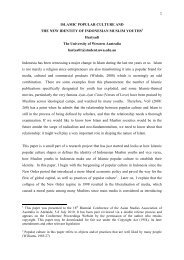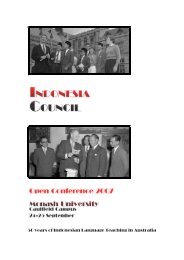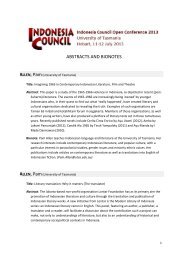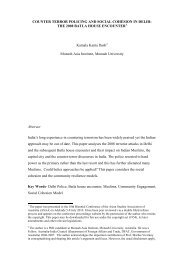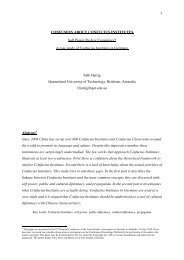the confiscation and shipment of Japanese war record paintings
the confiscation and shipment of Japanese war record paintings
the confiscation and shipment of Japanese war record paintings
Create successful ePaper yourself
Turn your PDF publications into a flip-book with our unique Google optimized e-Paper software.
1<br />
LISTING DISCREPANCIES:<br />
The Confiscation <strong>and</strong> Shipment <strong>of</strong> <strong>Japanese</strong> War Record Paintings 1<br />
Vincent Louie Tan<br />
Kyoto Institute <strong>of</strong> Technology<br />
vincent.villaescusa@gmail.com<br />
I. Introduction<br />
During <strong>the</strong> period <strong>of</strong> <strong>the</strong> Second Sino-<strong>Japanese</strong> War up to <strong>the</strong> end <strong>of</strong> World War II, a genre <strong>of</strong><br />
<strong>paintings</strong> called <strong>war</strong> <strong>record</strong> <strong>paintings</strong> 2 emerged in Japan. Many <strong>war</strong>-<strong>the</strong>med artworks were produced<br />
during this period. However, <strong>war</strong> <strong>record</strong> <strong>paintings</strong> were highly esteemed because <strong>the</strong>se were created by<br />
some <strong>of</strong> <strong>the</strong> most prominent <strong>Japanese</strong> artists <strong>of</strong> <strong>the</strong> period, under <strong>the</strong> commission <strong>of</strong> <strong>the</strong> <strong>Japanese</strong><br />
military government. These artists included Koiso Ryōhei, Miyamoto Saburō <strong>and</strong> <strong>the</strong> world famous<br />
Fujita Tsuguharu,. The majority <strong>of</strong> <strong>war</strong> <strong>record</strong> <strong>paintings</strong> were executed in <strong>the</strong> Western-style, that is, oil<br />
on canvas works <strong>and</strong> employed a realistic approach in depicting <strong>the</strong>ir subject matter.<br />
As <strong>the</strong> name states, <strong>the</strong> main purpose <strong>of</strong> <strong>the</strong> <strong>paintings</strong> was to <strong>record</strong> <strong>the</strong> events <strong>of</strong> <strong>the</strong> <strong>the</strong>n ongoing<br />
<strong>war</strong>. Moreover, <strong>the</strong> <strong>paintings</strong> also served a propag<strong>and</strong>a purpose. Aside from being featured <strong>and</strong><br />
1 This paper was presented to <strong>the</strong> 18 th Biennial Conference <strong>of</strong> <strong>the</strong> Asian Studies Association <strong>of</strong> Australia in Adelaide, 5-8<br />
July 2010. It has been peer reviewed via a double referee process <strong>and</strong> appears on <strong>the</strong> Conference Proceedings Website by<br />
<strong>the</strong> permission <strong>of</strong> <strong>the</strong> author who retains copyright. This paper may be downloaded for fair use under <strong>the</strong> Copyright Act<br />
(1954), its later amendments <strong>and</strong> o<strong>the</strong>r relevant legislation.<br />
2 Throughout <strong>the</strong> years, different terms have been used to refer to this genre <strong>of</strong> <strong>paintings</strong>. These include sensō-ga (<strong>war</strong><br />
painting) <strong>and</strong> sensō sakusen-ga (<strong>war</strong> operation painting). For <strong>the</strong> sake <strong>of</strong> uniformity, <strong>the</strong> author will use <strong>the</strong> term<br />
adopted by <strong>the</strong> Museum <strong>of</strong> Modern Art, Tokyo, <strong>the</strong> current home <strong>of</strong> <strong>the</strong> set <strong>of</strong> <strong>paintings</strong>, which is sensō kiroku-ga (<strong>war</strong><br />
<strong>record</strong> painting.)
2<br />
discussed extensively in various publications, including newspapers <strong>and</strong> art magazines, <strong>war</strong> <strong>record</strong><br />
<strong>paintings</strong> were also shown around Japan in well-publicized exhibitions sponsored by <strong>the</strong> military <strong>and</strong><br />
<strong>the</strong> Asahi Newspaper.<br />
When World War II ended, many <strong>of</strong> <strong>the</strong>se <strong>war</strong> <strong>record</strong> <strong>paintings</strong> were confiscated, informally at<br />
first, by personnel <strong>of</strong> <strong>the</strong> Office <strong>of</strong> <strong>the</strong> Chief Engineers <strong>of</strong> <strong>the</strong> Allied Powers. The confiscated <strong>paintings</strong><br />
were later exhibited at <strong>the</strong> Tokyo Municipal Museum (currently, <strong>the</strong> Tokyo Metropolitan Museum) in<br />
Ueno Park, exclusively to Allied personnel in late 1946. These were later kept in storage at <strong>the</strong> same<br />
institution. To<strong>war</strong>ds <strong>the</strong> end <strong>of</strong> <strong>the</strong> Occupation, <strong>the</strong> <strong>paintings</strong> were shipped to <strong>the</strong> United States.<br />
During this period <strong>of</strong> <strong>confiscation</strong>, storage <strong>and</strong> <strong>shipment</strong> <strong>of</strong> <strong>the</strong> <strong>paintings</strong>, a number <strong>of</strong> lists were created<br />
as part <strong>of</strong> <strong>the</strong>ir documentation. In 1970, <strong>the</strong> confiscated <strong>war</strong> <strong>record</strong> <strong>paintings</strong> made <strong>the</strong>ir way back to<br />
Japan under <strong>the</strong> terms <strong>of</strong> an “indefinite loan.” The <strong>paintings</strong> are now under <strong>the</strong> care <strong>of</strong> <strong>the</strong> National<br />
Museum <strong>of</strong> Modern Art in Tokyo.<br />
This paper owes its origins to <strong>the</strong> pioneering works on <strong>the</strong> subject <strong>of</strong> <strong>the</strong> <strong>confiscation</strong> <strong>of</strong><br />
<strong>Japanese</strong> <strong>war</strong> <strong>record</strong> <strong>paintings</strong> by Hirase Reita <strong>and</strong> Kawata Akihisa. In separate papers, Hirase <strong>and</strong><br />
Kawata were <strong>the</strong> first to extensively explore <strong>the</strong> <strong>confiscation</strong> <strong>of</strong> <strong>the</strong> <strong>war</strong> <strong>record</strong> <strong>paintings</strong> by <strong>the</strong> Allies.<br />
Both scholars discussed different listings <strong>of</strong> confiscated <strong>paintings</strong>. However, this paper will focus on<br />
Occupation-era lists created by Allied personnel to document <strong>the</strong> <strong>confiscation</strong> <strong>and</strong> <strong>shipment</strong> <strong>of</strong> <strong>the</strong><br />
<strong>paintings</strong>. Using <strong>the</strong>ir works as foundations, new attempts will be made to fill-in <strong>the</strong> critical gaps in<br />
<strong>the</strong>se previous works by introducing newly-uncovered documents.<br />
Different lists created by <strong>the</strong> <strong>confiscation</strong> authorities will be analyzed, some already introduced<br />
in previous studies like Hirase's papers entitled “War Art <strong>and</strong> America.” 3 Most <strong>of</strong> <strong>the</strong> lists in this paper,<br />
however, have only recently come to light. The present list <strong>of</strong> 153 <strong>war</strong> <strong>record</strong> <strong>paintings</strong> under<br />
indefinite loan at <strong>the</strong> National Museum <strong>of</strong> Modern Art, Tokyo will be used as a benchmark for <strong>the</strong><br />
comparison <strong>of</strong> <strong>the</strong> lists created during <strong>the</strong> Occupation era. By comparing <strong>the</strong> different lists created at<br />
various stages <strong>of</strong> <strong>the</strong> <strong>confiscation</strong> process, an attempt will be made to address some questions regarding<br />
<strong>the</strong> <strong>confiscation</strong> process. For example, how many <strong>paintings</strong> were <strong>of</strong>ficially confiscated by <strong>the</strong> Allies?<br />
Were <strong>the</strong>re <strong>paintings</strong> confiscated but not listed as such? Is <strong>the</strong>re a possibility <strong>of</strong> more confiscated<br />
<strong>Japanese</strong> <strong>war</strong> <strong>paintings</strong> currently in <strong>the</strong> custody <strong>of</strong> <strong>the</strong> US?<br />
3 Hirase Reita, “Sensōga to Amerika (War Art <strong>and</strong> America),” Bulletin <strong>of</strong> Himeji City Museum <strong>of</strong> Art, no. 3 (1999): pp. 8-<br />
10.
3<br />
II. Description <strong>of</strong> Lists<br />
As mentioned earlier, a number <strong>of</strong> lists were created by Allied personnel to document <strong>the</strong><br />
<strong>confiscation</strong> <strong>and</strong> <strong>shipment</strong> <strong>of</strong> <strong>Japanese</strong> <strong>war</strong> <strong>record</strong> <strong>paintings</strong>. These are <strong>the</strong> following:<br />
A. The MacArthur List<br />
This list was sourced from <strong>the</strong> MacArthur Memorial Library <strong>and</strong> Archives in Norfolk, Virginia. 4<br />
The list contains 152 items, <strong>the</strong> least amount <strong>of</strong> entries in all <strong>the</strong> lists that will be presented. It does not<br />
bear any date but <strong>the</strong> number <strong>of</strong> <strong>paintings</strong> in <strong>the</strong> list suggests that it is <strong>the</strong> earliest listing <strong>of</strong> <strong>the</strong><br />
confiscated <strong>paintings</strong>. The information in this list include <strong>the</strong> following: catalogue number, <strong>the</strong> name<br />
<strong>of</strong> <strong>the</strong> artist, title <strong>of</strong> <strong>the</strong> work, when <strong>the</strong> painting was created <strong>and</strong> where it was found at <strong>the</strong> time <strong>of</strong><br />
<strong>confiscation</strong>.<br />
B. The 1947 List<br />
This list bears <strong>the</strong> date “18 November 1947” <strong>and</strong> was earlier introduced by Hirase Reita in his<br />
paper on <strong>the</strong> same subject “War Paintings <strong>and</strong> America.” 5 The list was constructed from loose files <strong>of</strong><br />
photographs <strong>and</strong> index carded information. These can be found at <strong>the</strong> Modern <strong>Japanese</strong> Political<br />
History Materials Room <strong>of</strong> <strong>the</strong> National Diet Library in Tokyo. 6 The original documents can be found<br />
at <strong>the</strong> National Archives <strong>and</strong> Records Administration <strong>of</strong> <strong>the</strong> United States.<br />
The 1947 list basically contains <strong>the</strong> same information as <strong>the</strong> MacArthur List. However, <strong>the</strong><br />
1947 list contains FEC numbers. “FEC” mostly likely means “Far Eastern Commission” <strong>and</strong> <strong>the</strong><br />
numbers refer to <strong>the</strong> negatives <strong>of</strong> <strong>the</strong> photographs that came with <strong>the</strong> index-carded information. 7 The<br />
1947 list contains 153 items, one item more than <strong>the</strong> MacArthur list.<br />
C. The 1951 List<br />
Like <strong>the</strong> 1947 list, this list was also constructed from a set <strong>of</strong> loose files found in micr<strong>of</strong>iche<br />
form at <strong>the</strong> National Diet Library. 8 The files carry <strong>the</strong> date “24 July 1951,” only 2 days before <strong>the</strong><br />
<strong>paintings</strong> were taken out <strong>of</strong> storage from <strong>the</strong> Tokyo Municipal Museum in preparation for <strong>the</strong>ir<br />
<strong>shipment</strong> to <strong>the</strong> US. 9 The information in this list are essentially <strong>the</strong> same as <strong>the</strong> 1947 list <strong>and</strong> <strong>the</strong><br />
4 “Catalog Index <strong>of</strong> <strong>Japanese</strong> War Art Paintings,” Record Group 12: Collection <strong>of</strong> Photographs, PHA 140, MacArthur<br />
Memorial Library <strong>and</strong> Archives.<br />
5 Hirase, 1999, pp. 8-10.<br />
6 “Tab A – Photographs <strong>of</strong> <strong>Japanese</strong> War Art Paintings,” 18 November 1947, micr<strong>of</strong>iche, CIE (C) 06748 – CIE (C) 06752,<br />
Modern <strong>Japanese</strong> Political History Materials Room, National Diet Library, Tokyo.<br />
7 “<strong>Japanese</strong> War Painting,” 2 June 1951, micr<strong>of</strong>iche, CIE (B) 00818, ibid.<br />
8 “War Paintings,” 24 July 1951, micr<strong>of</strong>iche, CIE (C) 06746 - CIE (C) 06747, ibid.<br />
9 Shipment <strong>of</strong> confiscated <strong>Japanese</strong> <strong>war</strong> <strong>record</strong> <strong>paintings</strong> started on 26 July 1951. “Shipment <strong>of</strong> <strong>Japanese</strong> War Paintings,”<br />
13 October 1951, micr<strong>of</strong>iche, CIE (C) 06719, ibid.
MacArthur list. But <strong>the</strong> column indicating where <strong>the</strong> <strong>paintings</strong> were collected from is missing.<br />
In this list, a different set <strong>of</strong> FEC numbers were assigned to each painting, indicating that this<br />
set <strong>of</strong> photographs is different from <strong>the</strong> 1947 set <strong>of</strong> photographs. In a 27 April 1951 conference among<br />
concerned Occupation government divisions on what to do with <strong>the</strong> <strong>paintings</strong> before <strong>the</strong> end <strong>of</strong> <strong>the</strong><br />
Allied Occupation <strong>of</strong> Japan, it was stated that hardly any documents could be found regarding <strong>the</strong><br />
confiscated <strong>paintings</strong>. 10 Thus, this set <strong>of</strong> photographs seems to be a part <strong>of</strong> an effort to create fresh<br />
documentation for <strong>the</strong> confiscated <strong>paintings</strong>.<br />
A close examination <strong>of</strong> <strong>the</strong>se FEC numbers will reveal that <strong>the</strong> items from FEC-51-26372 up to<br />
FEC-51-26385, as well as FEC-51-26456 are missing. This amounts to 15 missing items. There is no<br />
indication in <strong>the</strong> documents, however, what <strong>the</strong>se items may be. Also, <strong>the</strong>re are two different <strong>paintings</strong><br />
with <strong>the</strong> same FEC number. These are Miyamoto Saburō's “Battle <strong>of</strong> Nicholson, Hong Kong” <strong>and</strong> Ōta<br />
Kijirō's “On Army Day” <strong>and</strong> have <strong>the</strong> number FEC-51-26436.<br />
Moreover, some <strong>of</strong> <strong>the</strong> index cards for <strong>the</strong> painting was marked ei<strong>the</strong>r “restricted” or “nonrestricted.”<br />
These, oddly enough, also correspond to <strong>the</strong> FEC numbers mentioned above. FEC-51-<br />
26371 <strong>and</strong> below were marked as non-restricted. FEC-51-26386 <strong>and</strong> above, except for FEC-51-26423,<br />
were marked restricted. Again, <strong>the</strong>re is no indication what <strong>the</strong>se marks refer to.<br />
This list contains 154 entries, <strong>the</strong> most number <strong>of</strong> items among <strong>the</strong> lists.<br />
D. 1951 Shipping List<br />
This list, courtesy <strong>of</strong> <strong>the</strong> US Army Center <strong>of</strong> Military History, is part <strong>of</strong> <strong>the</strong> documentation for<br />
<strong>the</strong> confiscated <strong>Japanese</strong> <strong>war</strong> <strong>record</strong> <strong>paintings</strong> for <strong>the</strong>ir <strong>shipment</strong> from Japan to <strong>the</strong> US in <strong>the</strong> latter part<br />
<strong>of</strong> 1951. 11 The list was prepared by <strong>the</strong> Office <strong>of</strong> <strong>the</strong> Chief <strong>of</strong> Engineers. Through this shipping list,<br />
one can ascertain how many <strong>paintings</strong> were <strong>of</strong>ficially confiscated <strong>and</strong> shipped to <strong>the</strong> US. The<br />
information in this list is similar to <strong>the</strong> <strong>the</strong> o<strong>the</strong>r list, but does not contain any FEC numbers.<br />
Moreover, <strong>the</strong> list also mentions <strong>the</strong> room number in which <strong>the</strong> painting was stored in at <strong>the</strong> Tokyo<br />
Municipal Museum. This information cannot be found in any <strong>of</strong> <strong>the</strong> o<strong>the</strong>r lists mentioned.<br />
A correlating document to this list is a condition report <strong>of</strong> each painting at <strong>the</strong> time <strong>of</strong> <strong>the</strong>ir<br />
<strong>shipment</strong> to <strong>the</strong> US. This document was prepared by <strong>the</strong> Shipping <strong>and</strong> Crating Division <strong>of</strong> <strong>the</strong><br />
Headquarters <strong>and</strong> Services Comm<strong>and</strong>. 12 The document reveals that many <strong>of</strong> <strong>the</strong> <strong>paintings</strong> were in<br />
excellent condition at <strong>the</strong> time <strong>of</strong> <strong>the</strong>ir <strong>shipment</strong> to <strong>the</strong> US. A number are in poor condition, however,<br />
10 “CIE Conference Report,” 27 April 1951, micr<strong>of</strong>iche, CIE (C) 08580, Modern <strong>Japanese</strong> Political History Materials<br />
Room, National Diet Library.Modern <strong>Japanese</strong> Political History Materials Room, National Diet Library.<br />
11 “Catalog Index <strong>of</strong> <strong>Japanese</strong> War Art Paintings,” 24 July 1951, US Army Center <strong>of</strong> Military History.<br />
12 “Condition: <strong>Japanese</strong> War Art Paintings,” 26 July 1951, US Army Center <strong>of</strong> Military History.<br />
4
5<br />
many suffering from water damage. This can be traced to <strong>the</strong> leaking ceilings <strong>of</strong> <strong>the</strong> Tokyo Municipal<br />
Museum, a matter that was discussed in some <strong>of</strong> <strong>the</strong> meetings conducted by Occupation personnel<br />
regarding <strong>the</strong> disposal <strong>of</strong> <strong>the</strong> <strong>paintings</strong>. 13<br />
Like <strong>the</strong> 1951 list, it also contains 154 items.<br />
E. The National Museum <strong>of</strong> Modern Art, Tokyo list (NMMA list)<br />
The NMMA list is from <strong>the</strong> <strong>of</strong>ficial museum catalogue <strong>of</strong> <strong>Japanese</strong> <strong>war</strong> <strong>record</strong>s <strong>paintings</strong>. 14 It<br />
contains 153 items <strong>and</strong> represents <strong>the</strong> total number <strong>of</strong> works brought back to Japan in 1970 on<br />
indefinite loan. Because <strong>of</strong> <strong>the</strong>se reasons, this list will be used as <strong>the</strong> basis for comparison among <strong>the</strong><br />
o<strong>the</strong>r lists.<br />
III. Additions <strong>and</strong> Subtractions<br />
The various lists mentioned above share a number <strong>of</strong> similarities. First <strong>of</strong> all, <strong>the</strong>y essentially<br />
contain <strong>the</strong> same set <strong>of</strong> <strong>paintings</strong>. Second, <strong>the</strong> catalogue numbers assigned to <strong>the</strong> <strong>paintings</strong> in <strong>the</strong><br />
Occupation-era documents remain <strong>the</strong> same throughout <strong>the</strong> different lists.<br />
However, as time went by, more <strong>paintings</strong> were constantly added to <strong>the</strong> collection. These later<br />
additions were appended at <strong>the</strong> end <strong>of</strong> <strong>the</strong> lists. For example, one painting was added to <strong>the</strong> 1947 list,<br />
bringing <strong>the</strong> total at that time to 153 works. This painting was Ōta Kijirō's “On Army Day.” In <strong>the</strong> list,<br />
<strong>the</strong> newly-added painting did not have a catalogue number but was assigned an FEC number, FEC-47-<br />
80941. Unlike <strong>the</strong> o<strong>the</strong>r <strong>paintings</strong> in <strong>the</strong> list, <strong>the</strong>re was no mention where <strong>the</strong> painting was found.<br />
In <strong>the</strong> 1951 list, ano<strong>the</strong>r painting was added, Tagami Hayao's “Portrait <strong>of</strong> Admiral Koga.” This<br />
brought <strong>the</strong> total <strong>of</strong> <strong>the</strong> list to 154 <strong>paintings</strong> confiscated, which corresponds to <strong>the</strong> number <strong>of</strong> <strong>paintings</strong><br />
in <strong>the</strong> shipping list.<br />
Because <strong>of</strong> <strong>the</strong> 1951 shipping list, it can now be proven that 154 items were <strong>of</strong>ficially<br />
confiscated <strong>and</strong> shipped to <strong>the</strong> US. This fact could not be ascertained in previous researches on <strong>the</strong><br />
subject because <strong>of</strong> <strong>the</strong> absence <strong>of</strong> this critical document. Any o<strong>the</strong>r <strong>paintings</strong> that may surface later on<br />
in <strong>the</strong> narrative <strong>of</strong> <strong>the</strong> <strong>confiscation</strong> <strong>and</strong> <strong>shipment</strong> <strong>of</strong> <strong>Japanese</strong> <strong>paintings</strong> to <strong>the</strong> US can be placed under<br />
scrutiny <strong>and</strong> questioned as to whe<strong>the</strong>r <strong>the</strong>y were <strong>of</strong>ficially confiscated by Occupation personnel or<br />
13 “Inspection <strong>of</strong> <strong>Japanese</strong> War Art,” 17 May 1950, micr<strong>of</strong>iche, CIE (A) 08566, Modern <strong>Japanese</strong> Political History<br />
Materials Room, National Diet Library.<br />
14 Catalogue <strong>of</strong> Collections, The National Museum <strong>of</strong> Modern Art, Tokyo: Watercolor <strong>and</strong> Drawings, Calligraphy,<br />
Sculpture, Supplementary Materials, War Record Paintings. (Tokyo: The National Museum <strong>of</strong> Modern Art, Tokyo,<br />
2006), pp. 196-211.
6<br />
acquired through o<strong>the</strong>r means not necessarily related or sanctioned by Allied forces.<br />
The <strong>of</strong>ficial number <strong>of</strong> <strong>Japanese</strong> <strong>war</strong> <strong>record</strong> <strong>paintings</strong> in <strong>the</strong> custody <strong>of</strong> <strong>the</strong> NMMA st<strong>and</strong>s at<br />
only 153 works. However, <strong>the</strong> documents presented above clearly show o<strong>the</strong>rwise. Part <strong>of</strong> <strong>the</strong><br />
discrepancy can be attributed to how <strong>the</strong> <strong>paintings</strong> were counted. Some <strong>of</strong> <strong>the</strong> confiscated <strong>paintings</strong> are<br />
works executed in multiple panels. For example, in <strong>the</strong> Occupation-era lists, Hashimoto Kansetsu's<br />
triptych entitled “Scenes Along <strong>the</strong> Hwangpu River on 8 December 1941” was counted as 3 separate<br />
works. In <strong>the</strong> NMMA catalogue, however, all three parts were counted as one work. If one is to use<br />
<strong>the</strong> same counting convention employed by <strong>the</strong> NMMA, <strong>the</strong> total number <strong>of</strong> <strong>paintings</strong> shipped to <strong>the</strong><br />
US would only amount to 152 works.<br />
In a 10 August 1946 memo issued by <strong>the</strong> Office <strong>of</strong> <strong>the</strong> Chief Engineer to <strong>the</strong> Chief <strong>of</strong> Staff <strong>of</strong><br />
<strong>the</strong> Occupation Forces, it was stated that 152 confiscated <strong>paintings</strong> were under <strong>the</strong> custody <strong>of</strong> <strong>the</strong><br />
Engineers <strong>and</strong> plans were being prepared for <strong>the</strong>se to be exhibited to Allied personnel. 15 This sum<br />
corresponds to <strong>the</strong> number <strong>of</strong> items in <strong>the</strong> previously mentioned MacArthur list, fur<strong>the</strong>r giving<br />
credence to <strong>the</strong> <strong>the</strong>ory that it is <strong>the</strong> earliest listing <strong>of</strong> confiscated <strong>Japanese</strong> <strong>war</strong> <strong>record</strong> <strong>paintings</strong>.<br />
However, if one is to reconcile <strong>the</strong> counting system <strong>of</strong> <strong>the</strong> 1946 list with <strong>the</strong> NMMA list, in 1946, <strong>the</strong>re<br />
were only 150 confiscated <strong>paintings</strong> in Allied custody.<br />
Later on, <strong>the</strong> number 153 confiscated <strong>Japanese</strong> <strong>war</strong> <strong>record</strong> <strong>paintings</strong> would <strong>of</strong>ten be repeated in<br />
various Occupation documents to refer to <strong>the</strong> amount <strong>of</strong> <strong>paintings</strong> confiscated. For example, in a 27<br />
April 1951 conference to discuss <strong>the</strong> final disposition <strong>of</strong> <strong>the</strong> confiscated <strong>paintings</strong> between <strong>the</strong> Office<br />
<strong>of</strong> <strong>the</strong> Chief Engineer, <strong>the</strong> Religion <strong>and</strong> Cultural Resources Section <strong>of</strong> <strong>the</strong> Civil Information <strong>and</strong><br />
Education Division <strong>and</strong> <strong>the</strong> Headquarters <strong>and</strong> Services Comm<strong>and</strong>, 153 was given as <strong>the</strong> definitive<br />
number <strong>of</strong> confiscated <strong>paintings</strong>. 16 The same number <strong>of</strong> confiscated works would be repeated in o<strong>the</strong>r<br />
documents relating to <strong>the</strong> <strong>confiscation</strong> <strong>and</strong> <strong>shipment</strong> <strong>of</strong> <strong>the</strong> confiscated <strong>Japanese</strong> <strong>war</strong> <strong>record</strong> <strong>paintings</strong>,<br />
from May to July 1951.<br />
It is easy to assume that since 153 <strong>paintings</strong> are now with <strong>the</strong> National Museum <strong>of</strong> Modern Art,<br />
all <strong>of</strong> <strong>the</strong> confiscated <strong>paintings</strong> were returned to Japan. This is, <strong>of</strong> course, a false assumption.<br />
A close comparison <strong>of</strong> <strong>the</strong> lists reveals that <strong>the</strong>re are 3 <strong>paintings</strong> listed as confiscated <strong>and</strong><br />
shipped to <strong>the</strong> US in <strong>the</strong> Occupation-era lists are not in <strong>the</strong> present NMMA collection. These <strong>paintings</strong><br />
are Okuse Eizō's “Air Fighting,” Katsuda Tetsu's “Divine Soldiers Descend on Menado” <strong>and</strong> Ueno<br />
15 “<strong>Japanese</strong> War Art Paintings,” 10 August 1946, micr<strong>of</strong>iche, CIE (C) 06719, Modern <strong>Japanese</strong> Political History Materials<br />
Room, National Diet Library.<br />
16 “Conference Report,” 27 April 1951, micr<strong>of</strong>iche, CIE (A) 08580, ibid.
7<br />
Kakuzō's “<strong>Japanese</strong> Attack on Nanking Castle.”<br />
If three <strong>paintings</strong> are “missing,” 4 <strong>paintings</strong> not listed in any <strong>of</strong> <strong>the</strong> Occupation-era lists made<br />
<strong>the</strong>ir way into <strong>the</strong> group <strong>of</strong> <strong>paintings</strong> now in <strong>the</strong> custody <strong>of</strong> <strong>the</strong> National Museum <strong>of</strong> Modern Art.<br />
These <strong>paintings</strong> are Kimura Makoto's “Front View <strong>of</strong> <strong>the</strong> Stronghold at Mount Xiaozhan” <strong>and</strong> “Rear<br />
View <strong>of</strong> <strong>the</strong> Stronghold at Mount Xiaozhan.” 17 These are <strong>paintings</strong> number 152 <strong>and</strong> 153, respectively,<br />
in <strong>the</strong> MoMAT list. Then, two Kurihara Shin <strong>paintings</strong>, NMMA catalog number 57 “ Charity” <strong>and</strong><br />
catalog number 58 “Escort <strong>of</strong> <strong>Japanese</strong> Residents” also cannot be found in any <strong>of</strong> <strong>the</strong> Occupation-era<br />
lists. So far, no documents can be found that refer to <strong>the</strong>se four later additions to <strong>the</strong> list <strong>of</strong> <strong>paintings</strong>.<br />
The only time when <strong>the</strong>re were actually only 153 works in <strong>the</strong> list <strong>of</strong> confiscated <strong>paintings</strong> was<br />
in 1947, as demonstrated by <strong>the</strong> set <strong>of</strong> photographs from which 1947 list was constructed. Thereafter,<br />
<strong>the</strong> <strong>of</strong>ficial number should have been 154. However, despite this, 153 seemed to be like a magic<br />
number that kept being repeated all <strong>the</strong> time, even after a careful documentation was done in late 1951,<br />
in preparation for <strong>the</strong> <strong>shipment</strong> <strong>of</strong> <strong>the</strong> <strong>paintings</strong> to <strong>the</strong> US. It would be tempting to conclude that since<br />
153 <strong>paintings</strong> were supposedly confiscated <strong>and</strong> <strong>the</strong>re are 153 <strong>paintings</strong> now in <strong>the</strong> care <strong>of</strong> <strong>the</strong> National<br />
Museum <strong>of</strong> Modern Art <strong>the</strong>n all <strong>of</strong> <strong>the</strong> confiscated <strong>paintings</strong> made <strong>the</strong>ir way back to Japan. This is not<br />
<strong>the</strong> case, however, as <strong>the</strong> comparison <strong>of</strong> <strong>the</strong> lists shows.<br />
V. Conclusions<br />
A fatal flaw in <strong>the</strong> previous works on <strong>the</strong> subject <strong>of</strong> <strong>the</strong> <strong>confiscation</strong> <strong>and</strong> <strong>shipment</strong> <strong>of</strong> <strong>Japanese</strong><br />
<strong>war</strong> <strong>record</strong> <strong>paintings</strong> by <strong>the</strong> Occupation forces during <strong>the</strong> Allied Occupation <strong>of</strong> Japan is <strong>the</strong> belief that<br />
only 153 items were confiscated <strong>and</strong> shipped to <strong>the</strong> US. New documents clearly show that this was not<br />
<strong>the</strong> case.<br />
The discrepancies found in <strong>the</strong> Occupation-era lists <strong>and</strong> <strong>the</strong> present set <strong>of</strong> <strong>paintings</strong> in <strong>the</strong><br />
custody <strong>of</strong> <strong>the</strong> National Modern Art Museum raises a number <strong>of</strong> important questions regarding <strong>the</strong><br />
<strong>confiscation</strong> <strong>of</strong> <strong>Japanese</strong> <strong>war</strong> <strong>record</strong> <strong>paintings</strong> during <strong>the</strong> Allied Occupation <strong>of</strong> Japan. Foremost <strong>of</strong><br />
<strong>the</strong>se is how many <strong>paintings</strong> were actually confiscated <strong>and</strong> how many <strong>of</strong> <strong>the</strong>se were sent to <strong>the</strong> US?<br />
The absence <strong>of</strong> <strong>the</strong> two Kurihara Shin <strong>and</strong> two Kimura Makoto <strong>paintings</strong> in any <strong>of</strong> <strong>the</strong> listings <strong>of</strong><br />
confiscated <strong>Japanese</strong> <strong>war</strong> <strong>record</strong> <strong>paintings</strong> hints that <strong>the</strong>se works may have been un<strong>of</strong>ficially<br />
17 The two Kimura Makoto <strong>paintings</strong> were created in 1915, many years before <strong>the</strong> 15 Years War, <strong>and</strong> are not <strong>of</strong>ficial <strong>war</strong><br />
<strong>record</strong> <strong>paintings</strong>. Catalogue <strong>of</strong> Collections, The National Museum <strong>of</strong> Modern Art, Tokyo: Watercolor <strong>and</strong> Drawings,<br />
Calligraphy, Sculpture, Supplementary Materials, War Record Paintings, p. 211.
confiscated.<br />
On 1 October 1951, <strong>the</strong> Department <strong>of</strong> Military History in Washington, DC acknowledged that<br />
<strong>the</strong>y received <strong>the</strong> <strong>shipment</strong> <strong>of</strong> <strong>Japanese</strong> <strong>war</strong> <strong>record</strong> <strong>paintings</strong> from Japan. However, <strong>the</strong> documents<br />
accompanying <strong>the</strong> <strong>shipment</strong> <strong>of</strong> <strong>paintings</strong> were incomplete <strong>and</strong> do not reflect <strong>the</strong> exact number <strong>of</strong><br />
<strong>paintings</strong> in <strong>the</strong> <strong>shipment</strong>. Thus, <strong>the</strong> department requested <strong>the</strong> Occupation <strong>of</strong>ficials concerned with <strong>the</strong><br />
<strong>confiscation</strong> to furnish <strong>the</strong>m a complete listing <strong>of</strong> <strong>the</strong> <strong>paintings</strong> shipped. 18 As a response, Office <strong>of</strong> <strong>the</strong><br />
Chief Engineer sent <strong>the</strong> shipping list previously mentioned in this paper. Moreover, <strong>the</strong> <strong>of</strong>fice also sent<br />
a set <strong>of</strong> 153 photographs <strong>of</strong> <strong>the</strong> confiscated <strong>paintings</strong> to accompany <strong>the</strong> shipping lists, plus <strong>the</strong><br />
condition list <strong>of</strong> each painting in custody. These photographs were taken 2 days before <strong>the</strong> activities<br />
were started to ship <strong>the</strong> <strong>paintings</strong> to <strong>the</strong> US. It was already established that <strong>shipment</strong> started on 26 July<br />
1951. 19 Thus, <strong>the</strong> photographs from which <strong>the</strong> previously introduced 1951 list was constructed from<br />
can be said to be <strong>the</strong> same set <strong>of</strong> photographs sent to Military History. However, as was stated earlier,<br />
<strong>the</strong> number <strong>of</strong> <strong>paintings</strong> in that particular set <strong>of</strong> photographs totaled 154 items. 20<br />
Part <strong>of</strong> this confusion on <strong>the</strong> exact number <strong>of</strong> <strong>paintings</strong> can be attributed to <strong>the</strong> fact that details<br />
regarding <strong>the</strong> <strong>confiscation</strong> <strong>of</strong> <strong>the</strong> works, from 1945 up to <strong>the</strong> middle <strong>of</strong> 1946, was not very clear to <strong>the</strong><br />
Occupation personnel by 1951. In a meeting between <strong>the</strong> Office <strong>of</strong> <strong>the</strong> Chief Engineer, <strong>the</strong> Religion<br />
Cultural Resources Division <strong>of</strong> <strong>the</strong> Civil Information <strong>and</strong> Education Section <strong>and</strong> <strong>the</strong> Headquarters <strong>and</strong><br />
Services Comm<strong>and</strong> to discuss <strong>the</strong> final disposition <strong>of</strong> <strong>the</strong> <strong>paintings</strong>, it was stated that none <strong>of</strong> <strong>the</strong><br />
participants in <strong>the</strong> meetings were well-informed about <strong>the</strong> subject at h<strong>and</strong>. 21 Whatever information <strong>the</strong>y<br />
had was taken from fragmentary documents. Moreover, <strong>the</strong> impetus for a review <strong>of</strong> <strong>the</strong> confiscated<br />
<strong>paintings</strong> seemed to have stemmed from <strong>the</strong> clamor that <strong>the</strong> Allies received requests for <strong>the</strong> release <strong>of</strong><br />
<strong>the</strong> space in which <strong>the</strong> confiscated <strong>paintings</strong> were being stored at <strong>the</strong> Tokyo Municipal Museum. The<br />
petitions came from various <strong>Japanese</strong> art groups who desired to use <strong>the</strong> museum's space for <strong>the</strong>ir<br />
groups' exhibitions.<br />
The three now missing <strong>paintings</strong> <strong>and</strong> <strong>the</strong> four <strong>paintings</strong> that were not in any <strong>of</strong> <strong>the</strong> Occupationera<br />
lists but are now part <strong>of</strong> <strong>the</strong> NMMA catalogue begs <strong>the</strong> following questions. First, what was <strong>the</strong><br />
actual number <strong>of</strong> <strong>paintings</strong> confiscated during <strong>the</strong> Occupation period? Second, are <strong>the</strong>re still more<br />
18 “Shipment <strong>of</strong> <strong>Japanese</strong> War Paintings,” 21 October 1951, micr<strong>of</strong>iche, AG (C) 02214, Modern <strong>Japanese</strong> Political History<br />
Materials Room, National Diet Library.<br />
19 “Shipment <strong>of</strong> <strong>Japanese</strong> War Paintings,” 13 October 1951, micr<strong>of</strong>iche, CIE (C) 06719, ibid.<br />
20 If one was to count <strong>the</strong> <strong>paintings</strong> by <strong>the</strong>ir FEC numbers, <strong>the</strong> total would be 153. This is because <strong>the</strong>re were two works<br />
sharing <strong>the</strong> same FEC number. These works are catalog number 63, “Battle <strong>of</strong>f Nicholson, Hong Kong” by Miyamoto<br />
Saburō <strong>and</strong> catalog number A-6, “On Army Day” by Ōta Kijirō.<br />
21 “Conference Report,” 27 April 1951, micr<strong>of</strong>iche, CIE (A) 08580, Modern <strong>Japanese</strong> Political History Materials Room,<br />
National Diet Library.<br />
8
<strong>Japanese</strong> <strong>war</strong> <strong>paintings</strong> in US h<strong>and</strong>s that were not placed under indefinite loan at <strong>the</strong> Museum <strong>of</strong><br />
Modern Art, Tokyo? One question can hardly be discussed without touching on <strong>the</strong> o<strong>the</strong>r.<br />
With <strong>the</strong> shipping documents at h<strong>and</strong>, it is certain that 154 items were <strong>of</strong>ficially sent to <strong>the</strong> US.<br />
However, <strong>the</strong> present collection at <strong>the</strong> National Museum <strong>of</strong> Modern Art only amounts to 153 works. It<br />
is important to point out again that <strong>the</strong> way <strong>the</strong> <strong>paintings</strong> were counted differs in both <strong>the</strong> Occupationera<br />
lists <strong>and</strong> <strong>the</strong> present catalogue listing <strong>of</strong> <strong>war</strong> <strong>record</strong> <strong>paintings</strong> <strong>of</strong> <strong>the</strong> Museum <strong>of</strong> Modern Art, Tokyo.<br />
If one was to use <strong>the</strong> museum's counting convention to add up <strong>the</strong> number <strong>of</strong> <strong>paintings</strong> <strong>of</strong>ficially<br />
confiscated, <strong>the</strong>n only 152 <strong>paintings</strong> were confiscated <strong>and</strong> shipped to <strong>the</strong> US during <strong>the</strong> Occupation<br />
period. 22<br />
Given <strong>the</strong> documents at h<strong>and</strong>, it is quite possible that <strong>the</strong> two Kurihara Shin <strong>paintings</strong> <strong>and</strong> <strong>the</strong><br />
two Kimura Makoto <strong>paintings</strong> were obtained through means o<strong>the</strong>r than <strong>confiscation</strong>. There seems to be<br />
no documents to ascertain how <strong>the</strong>se fell into Allied h<strong>and</strong>s. Consequently, <strong>the</strong>y were not part <strong>of</strong> <strong>the</strong><br />
<strong>of</strong>ficial listing <strong>of</strong> 154 <strong>paintings</strong> confiscated.<br />
Branches <strong>of</strong> <strong>the</strong> US Military maintain military history branches <strong>and</strong> some <strong>of</strong> <strong>the</strong>se deal with art.<br />
One <strong>of</strong> <strong>the</strong>se Department <strong>of</strong> <strong>the</strong> Navy's Naval Historical Center operates out <strong>of</strong> Washington DC. The<br />
center h<strong>and</strong>les <strong>the</strong> Navy Art Collection, whose collection can be viewed online. 23 A careful search <strong>of</strong><br />
<strong>the</strong> art database online revealed two entries for <strong>Japanese</strong> <strong>war</strong> <strong>paintings</strong>. One <strong>of</strong> <strong>the</strong>se is a portrait <strong>of</strong> <strong>the</strong><br />
crew <strong>of</strong> a <strong>Japanese</strong> midget submarine who perished during <strong>the</strong> attack on Pearl Harbor. The item<br />
number for <strong>the</strong> painting is NH 86388-KN. 24 The o<strong>the</strong>r painting is item number NH 79462-KN, which<br />
is a portrait <strong>of</strong> Admiral Isoroku Yamamoto painted by Shugaku Homma. 25 These two <strong>paintings</strong> are also<br />
not in any <strong>of</strong> <strong>the</strong> list <strong>of</strong> <strong>of</strong>ficially confiscated <strong>paintings</strong> created during <strong>the</strong> Occupation period. The<br />
website, unfortunately, does not give much information regarding <strong>the</strong> <strong>paintings</strong>, o<strong>the</strong>r than its Navy Art<br />
Collection catalogue number <strong>and</strong> title. A letter was sent by <strong>the</strong> author to Navy History on 16 July 2010<br />
requesting for more information on <strong>the</strong> <strong>paintings</strong> found in <strong>the</strong> Navy History website. However, no<br />
reply was received at <strong>the</strong> time <strong>of</strong> <strong>the</strong> writing <strong>of</strong> this paper. Thus, <strong>the</strong> provenance <strong>of</strong> <strong>the</strong> <strong>paintings</strong> in<br />
question cannot be ascertained. This opens <strong>the</strong> possibility <strong>of</strong> <strong>the</strong> actual <strong>paintings</strong> still being in US<br />
h<strong>and</strong>s. The three missing <strong>paintings</strong> from <strong>the</strong> Occupation era lists, however, remain unaccounted for<br />
22 The NMMA catalogue counts Hashimoto Kansetsu's triptych “ Scenes Along <strong>the</strong> Hwangpu River on 8 December 1941”<br />
as one piece. The Occupation-era lists count this painting as 3 separate pieces.<br />
23 Part <strong>of</strong> <strong>the</strong> Navy Art Collection can be accessed via http://www.history.navy.mil/branches/org11-2.htm .<br />
24 “Online Library <strong>of</strong> Selected Images, Pearl Harbor Attack, 7 December 1941,” Naval History <strong>and</strong> Heritage Comm<strong>and</strong>,<br />
http://www.history.navy.mil/photos/images/h86000/h86388kc.htm , 18 February 2000 (accessed 30 August 2010).<br />
25 “Online Library <strong>of</strong> Selected Images, Admiral Yamamoto Isoroku, Imperial <strong>Japanese</strong> Navy (1884-1943),” Naval History<br />
<strong>and</strong> Heritage Comm<strong>and</strong>, http://www.history.navy.mil/photos/images/h86000/h86388kc.htm , 28 April 1999 (accessed 30<br />
August 2010).<br />
9
10<br />
<strong>and</strong> may also still be in <strong>the</strong> US.<br />
At this point, it is difficult to establish just how many <strong>Japanese</strong> <strong>war</strong> <strong>paintings</strong> were shipped to<br />
<strong>the</strong> US. Relying on <strong>the</strong> shipping documents alone is clearly not enough. Moreover, it seems that <strong>the</strong><br />
Occupation personnel were less than forthright in <strong>the</strong> documentation <strong>of</strong> <strong>the</strong>ir <strong>confiscation</strong> <strong>and</strong> shipping<br />
<strong>of</strong> <strong>the</strong> <strong>Japanese</strong> <strong>war</strong> <strong>record</strong> <strong>paintings</strong>. Confusion is clearly evident in <strong>the</strong> fragmentary nature <strong>of</strong> <strong>the</strong><br />
documents that <strong>the</strong> activity left behind.<br />
In 1951, it was not very easy to not see <strong>the</strong> significance <strong>of</strong> <strong>the</strong> <strong>Japanese</strong> <strong>war</strong> <strong>record</strong> <strong>paintings</strong><br />
<strong>and</strong> it was convenient to dismiss <strong>the</strong>se works as mere propag<strong>and</strong>a. In fact, several Occupation<br />
documents expressed this kind <strong>of</strong> evaluation <strong>of</strong> <strong>the</strong> confiscated <strong>paintings</strong>, from <strong>the</strong> beginning <strong>of</strong> <strong>the</strong>ir<br />
<strong>confiscation</strong> up to <strong>the</strong> point <strong>of</strong> <strong>the</strong>ir <strong>shipment</strong>. It is only in hindsight that <strong>the</strong>se works, no matter how<br />
controversial <strong>the</strong>ir <strong>the</strong>me <strong>and</strong> <strong>the</strong> circumstance <strong>of</strong> <strong>the</strong>ir creation, gain greater significance through <strong>the</strong><br />
lenses <strong>of</strong> history.
11<br />
Table 1: Comparison <strong>of</strong> number <strong>of</strong> <strong>paintings</strong> per list<br />
Name <strong>of</strong> List No. <strong>of</strong> Works Remarks<br />
MacArthur List 152<br />
1947 List 153<br />
1951 List 154<br />
- same as MacArthur list<br />
- plus Ōta Kijirō's “On Army Day”<br />
Shipping List 154 - same a 1951 list<br />
MoMAT List 153<br />
- plus Ōta Kijirō's “On Army Day”<br />
- plus Tagami Hayao's “Portrait <strong>of</strong> Admiral Koga”<br />
- 3 missing <strong>paintings</strong> from <strong>the</strong> Occupation-era lists<br />
- additional 4 <strong>paintings</strong> not in any Occupation-era list<br />
• If <strong>the</strong> counting system <strong>of</strong> <strong>the</strong> NMMA is used, only 152 <strong>paintings</strong> were “<strong>of</strong>ficially” confiscated <strong>and</strong> sent to <strong>the</strong><br />
United States.
12<br />
Bibliography<br />
Hariu Ichirō, et al, eds. Sensō to Bijutsu 1937-1945 (Art in Wartime Japan 1937-1945). Tokyo:<br />
Kokushokankokai Inc., 2007.<br />
Hirase Reita. "Sensōga to Amerika (War Art <strong>and</strong> America)." Bulletin <strong>of</strong> Himeji City Museum <strong>of</strong> Art,<br />
no. 3 (1999): 1 - 40.<br />
Kawata Akihisa. "Sensō kirokuga ni kansuru mitsu no risuto – Taishō Hyō oyobi Kaidai (Three Lists<br />
<strong>of</strong> War Record Paintings - Comparison <strong>and</strong> Annotations)." The Kajima Foundation for <strong>the</strong> Arts<br />
Annual Report, no. 15 supplement (1997): 410 - 428.<br />
Kawata Akihisa. "Sorera wo Dō Sureba Yoi no ka? Beikoku Kōbunsho ni Miru Sensō kirokuga no<br />
Sesshū no Keii (What is to be Done with Them? Looking into <strong>the</strong> Chronology <strong>of</strong> <strong>the</strong><br />
Confiscation <strong>of</strong> War Record Paintings through <strong>the</strong> American National Archives." Kindai<br />
Gasetsu, no. 8 (1999): 1 - 41.<br />
Kousaka Jirou, et al. Gakatachi no Sensō (The Artists' War). Tokyo: Shinchosha, 2010.<br />
Tsuruya Mayu. "Sensō Sakusen Kirokuga (War Campaign Documentary Painting): Japan's National<br />
Imagery <strong>of</strong> <strong>the</strong> 'Holy War,' 1937-1945." Phd dissertation, University <strong>of</strong> Pittsburgh, 2005.<br />
"Catalogue Index <strong>of</strong> <strong>Japanese</strong> War Art Paintings." US Army Center <strong>of</strong> Military History.<br />
Catalogue <strong>of</strong> Collections, The National Museum <strong>of</strong> Modern Art: Watercolor <strong>and</strong> Drawings,<br />
Calligraphy, Sculpture, Supplementary Materials, War Record Paintings. Tokyo: The National<br />
Museum <strong>of</strong> Modern Art, Tokyo, 2006.<br />
"Materials on <strong>the</strong> Allied Occupation <strong>of</strong> Japan." micr<strong>of</strong>iche. Modern <strong>Japanese</strong> Political History<br />
Materials Room, National Diet Library, Tokyo.<br />
"Online Library <strong>of</strong> Selected Images, Admiral Yamamoto Isoroku, Imperial <strong>Japanese</strong> Navy (1884-<br />
1943)." Naval History <strong>and</strong> Heritage Comm<strong>and</strong>. 28 April 1999.<br />
http://www.history.navy.mil/photos/images/h79000/h79462kc.htm (accessed 30 August 2010).<br />
"Online Library <strong>of</strong> Selected Images, Pearl Harbor Attack, 7 December 1941" Naval History <strong>and</strong><br />
Heritage Comm<strong>and</strong>. 18 February 2000.<br />
http://www.history.navy.mil/photos/images/h86000/h86388kc.htm (accessed 30 August 2010).<br />
"Record Group 12: Collection <strong>of</strong> Photographs." MacArthur Memorial Library <strong>and</strong> Archives.<br />
“Sensō Kirokuga Shūfuku Hōkoku (Report on <strong>the</strong> Restoration <strong>of</strong> War Record Paintings).” Tokyo:<br />
National Museum <strong>of</strong> Modern Art, Tokyo, 1978.


